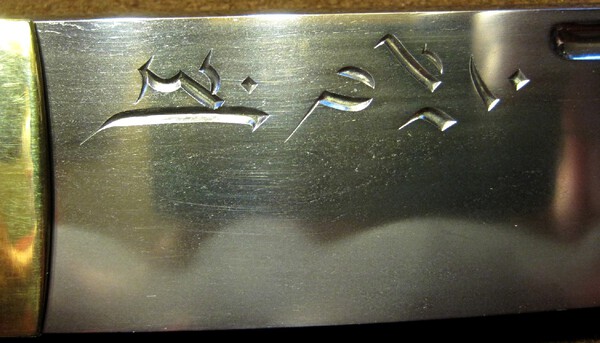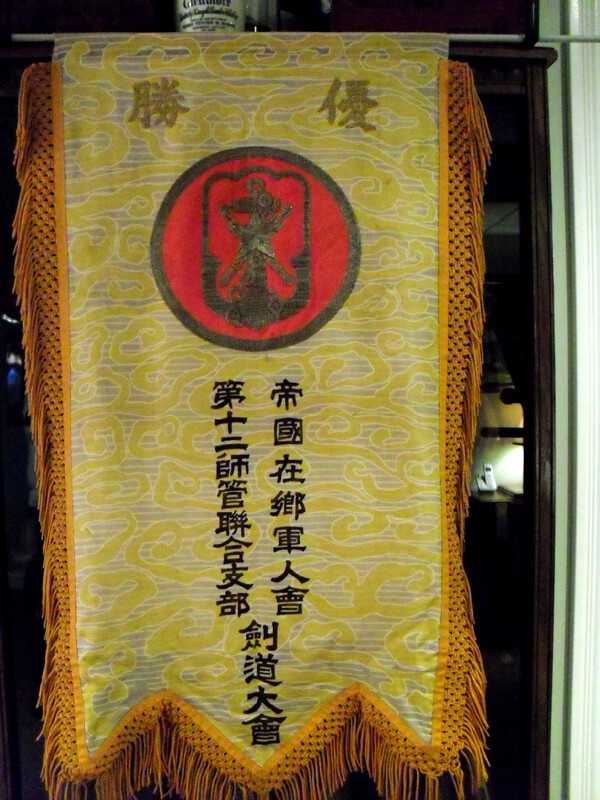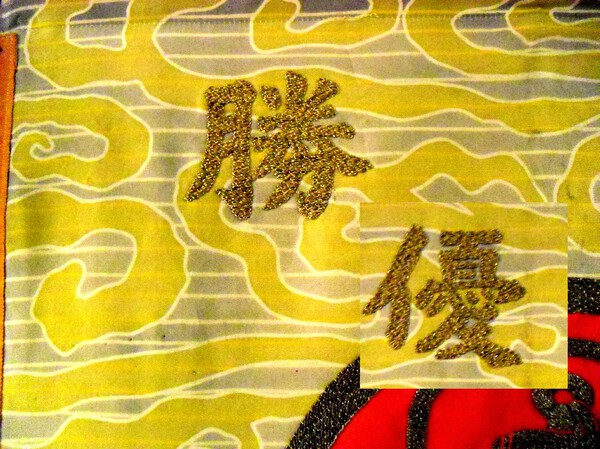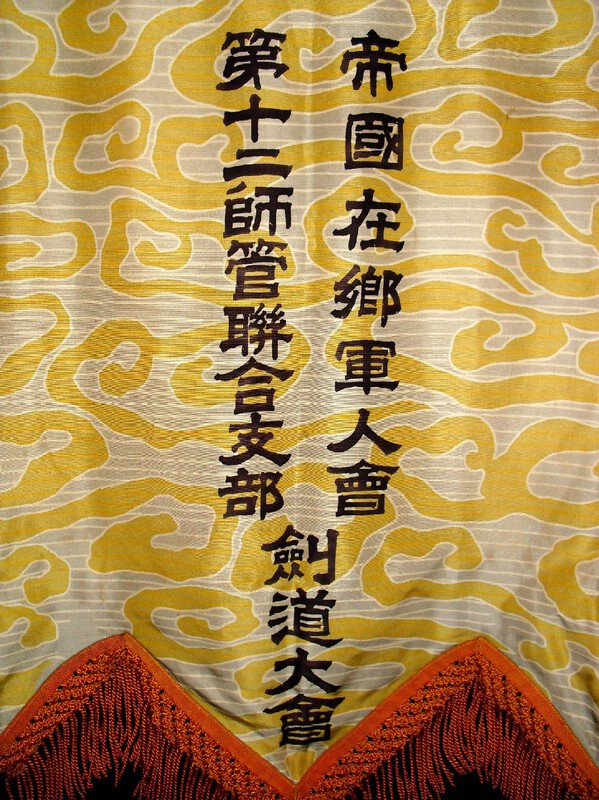-
Posts
703 -
Joined
-
Last visited
-
Days Won
4
Content Type
Profiles
Forums
Events
Store
Downloads
Gallery
Everything posted by Ron STL
-
It was nice to see Tsuruta san at the Tampa sword show this year, if I have the correct show. Ron STL
-
Makes me think of another blade here, a powerful shape that I always felt was a variation of kikuchi yari. Finally had the paper's description translated. They called it "unusual shape." Ron STL
-
That's right, Barry. One of my favorite shapes is the kikuchi yari. I have one kikuchi yari, nakago modified for use as a tanto. My long ago missed opportunity was to buy a boxed, documented and ubu kikuchi yari, originally a gift to some St. Louisian during our 1904 World Fair from a visiting Japanese. Had limited knowledge and even less $$$ when it was available. Today (I think) it resides in England. Jean, you mentioned shobu-zukuri. I believe shobu-zukuri shape brings the shinogi all the way up the the very tip. When it ends well behing the very tip it becomes unokubi. If it has a yokote, it becomes Kamuri-otoshi. However, I find these names interchanged a lot which doesn't help. Ron STL
-
I suspect this is simply an unokubi wakizashi that has been shortened and not a naginata-naoshi. Here is another such blade (sorry for the poor quality photo) which ubu and signed NANTO KANABO HAYATORYŌ MASASANE SAKU (MASAZANE) Ron STL
-
The mei on this yari is rather interesting in that it allows comparison to the changing mei of the Yasutsugu. The yari is certainly out-of-polish by has a nice shape and ubu nakago. I'm convinced (99.9%) that the mei matches the mei of 8th generation Yasutsugu. This chart showing the kanji variations is in Fujishiro and elsewhere. Does anyone wish to agree or disagree with my opinion? I'm always open-minded on such things. A second part of this topic are the numbers that appear at the very end of the nakago. I'm not sure if the first kanji is truly a number or not, but the rest are clearly numbers. My guess is that these were something like arsenal inventory numbers??? Again, I'd enjoy some thoughts on their meaning. The yari is 4-sided, a little waisted shape, 8-faceted base, 16.5 cm in length with 34.6 cm nakago with kengyo end. Interest? No iterest? ...let's see. Ron STL
-
Yoshitane‘s scales are cut in a way that it looks as if coins were laid each on the other... his trade mark. Thanks Eric, that certainly is a good way to describe the scales in the detail. I've never heard this put this way before regarding Yoshitane's style of carving. Thanks for pointing this out. Ron STL
-
Finally, here is hori that is carved into a bo-hi on a katana by Chikuzen Munetsugu (Chiuzen Ishido). The ura display beautiful double narrow hi. It is a beautiful sword. So there you have it. If anyone cares to comment on any of these examples, have at it, but realize my less than professional quality photos could be better. :? Ron STL
-
This second example is on a short katana, mumei, attributed (Minneapolis shinsa) to Heiuezaimon Tadamitsu ca. 1504. There is some significance to the three wraps of the dragon's tail as opposed to if it had only two wraps...regarding when it was made. Again, photos do not do the hori full justice. Ron STL
-
Well, I photographed three examples of hori on three different swords. Not too happy with my photography but I'll post them FYI. The first is of a Naotane, special order utsushi (noted "one of ten utsushi"). It has been felt that this was carving by Yoshitane although the shinsa team did not make mention of that, from what I understand from the papers. Interesting to note, on the photo of the bonji you can see some of Naotane's "whirlpool hada" which shows up on this kowakizashi. I'll post these three examples individually. Ron STL
-
Wonderful photography, Eric, and yes, the use of shadows certainly makes the point very clear! Today, I had the original sword under discussion in-hand again. Looking closely at the areas pointed out by Chris as being less than 1st class carving, the problem(s) could be seen and better understood. I also looked at another example today that displayed truly wonderful carving and the differences were obvious. If I can get some good photos, I'll try and post photos of three examples of hori that I have here. One example is on a Naotane (hori thought to be by Yoshitane), the other is on a sue-Bizen wakizashi and the third is on a Chikuzen Munetsgug where the hori is carved within a bo-hi. It would be fun to share these while also enoying other examples from NMB members. Nothing compares with "in-hand" study, but this will help our understanding and recognition of hori. Ron STL
-
Interesting observations, Chris. Handling this sword yesterday I thought the horimono looks rather well made, but I'll be the first to say that I've had little experience in judging horimono other than hi. The undesireable workmanship you pointed out did not catch my eye when handling the sword. I may get the sword into my hands again and will then be sure to take a closer look at the carving. The Soshu style of horimono coupled with the Soshu shape of the nakago and then seeing remnants of a mei set in the middle of the nakago, tachi-mei, is what peaked my interest in the sword. I ended up spending more time searching my library for examples of the hori to see who might had made it than I did taking note of the quality of the hori. Besides the hori, the sword is in old katana koshirae that appears to predate Meiji times. As for the blade itself, yes, it does show wear which has resulted in open grain in the monouchi on one side. The utsuri bothers me because of how it shows up right at the hamachi. I do not detect mizukage unless it is fooling me by being in this form looking more like utsuri. The ko-nie quality along (what I can see) of the hamon is good quality, crisp and clear. My problem is, I see an old survivor like this and find myself wanting to have it restored and preserved. Of course that gets expensive and often impractical if the sword's quality is just not there. Thanks for "pointing my nose" more closely to the hori, Chris. As we advise the new guys, one never stops learning! Ron STL
-
-
This daito has become a challenge and it would be interesting to receive some feedback from others as to what this sword might be. You can see the very Soshu-looking nakago and horimono. Searching, I've not found another exact example of this style of dragon other than a line-drawing in a Token Society/GB publication, A Dictionary of JS Terms by Fuller. The nakago does have some remnants of a mei (tachi mei) which seem to in a very old style, but I can not see enough to venture a reading. Hamon is as it shows, a suguha but not pure suguha. Horimono is elaborate on both sides of the sword and both sides end below the yokote with double-narrow hi. Polish prohibits and real reading of the jigane. There are a couple open areas within the jigane (at or below the monouchi) which would be nice if not there, but age... One puzzle of sorts, you can see utsuri existing at the ha-machi. Could this be mizukage, but it appears rather natural and not as an obvious 40 degree line as if retempered. All in all it is an interesting sword that I may venture into just to see what restoration might result in. Any comments will help make this decision but whatever, it still remains an interesting old sword that has the survived centures! Kind of what it's all about, eh? Ron STL
-
John, the sword is actually signed Amihide. Thanks guys for making the worksheet comment clear. Is there any possibility that this would be as John asked above? Obviously the shinsa team did not feel this was a daimei since daimei would be accepted, right? Ron STL
-
Back home again since the Tampa shinsa, a more clear explanation of a Japanese term would be greatly appreciated. Attached is what was written down by the shinsa team. We heard what it was supposed to be saying, but maybe understanding the word shirotoma would help fully clear up things. Nidai shirotoma...reportedly the sword was made by nidai Masahide and then signed with his father's late-in-life name, Amihide, making the sword a gimei as if made by shodai himself. If more can be said about this term and perhaps more on why the son would had done this and why...well, it just seems there is some "learning" possible here. Chris did his best to explain such puzzles during the weekend, but he could only do so much...why I thought this would be the place to elaborate on this particular question. Thanks! Ron STL
-

Tampa 2014 report
Ron STL replied to Grey Doffin's topic in Sword Shows, Events, Community News and Legislation Issues
Having just spent a bundle at home before the show, I went down primarily for the shinsa and to look around the show, visit with old friends and to enjoy a few beers poolside, soaking up some sunshine! I was impressed with how busy the show was. Tables were filled and there was a "buzz" in the air. People were having fun, buying and selling. I missed handling the Akihiro but that was my own fault. Chris and his crew did a wonderful job keeping the shinsa on track and accommodating people. While it was disappointing that Miyano sensei could not make the trip, the shinsa team held to expectations for the NTHK(NPO). (Six passes out of seven submissions, I was quite pleased!) There was also some fun afterhours sessions in the lounge. Jim Gilbert and I sat at the bar together and soon, some fittings came out for study. A few others joined in and soon, it was like "old times" as five or six of us enjoyed each other's tosogu items. The NBTHK/American exhibit was super, being a fancier of early tosogu. Jim and Bob Benson did their usual excellent job commenting on what was laid out for in-hand study. Regrets? Well, maybe that Jim was able to buy a couple wonderful tsuba and I missed them. Ron STL -
Thanks everyone, that's some interesting information. I'll pass this on to my friend out in Louisville, Kentucky. I believe it is something an uncle brought back -- an Iwo veteran/survivor -- and a keepsake. Appreciate the explaination; totally beyond my reading of the Japanese, for sure. Thanks again! Ron STL
-
Hope this is okay to post this here. A friend asked for help in identifying this flag, or more likely, banner. It looks to be of good quality and must have been of some importance. I'm as curious as he is. Can anyone explain what this is??? Measures 42" x 22" and is two-sided. Thanks! Ron STL
-
I believe there was a feature article in National Geographic this year, last year...on the town of Hagi. Just FYI...Ron STL
-
Hi Robert - Thanks for sharing your first tsuba selection with us. I've always enjoyed good Choshu tsuba; the tsuba at right that I identify with is Choshu. I've always heard that those tsuba using the town name "Hagi" in their mei are a step up from those without this place-name. I think those are also the more earlier made tsuba, if memory serves correctly. It's interesting that Choshu tsuba show both sides of the theme. If you would have a plum branch and blossomes, one side would show the front of the blossoms, the other side, the backside of the blossoms. A them like you have, I wonder how that is handled. Just me, but it always kind of puzzles me why everyone (today?) wants to "dress up" a sword to their taste. Your AOI sword purchase is likely in shirasaya; your tsuba is very enjoyable and in a box for nice presentation. Why not just enjoy each of these as they are; stand alone items to be enjoyed? Just an old man's thinking...sorry. Ron STL
-
Thanks Eric, for pointing this out. I see this is an error in the English translation of Fujishiro; the Japanese text does read "Jo-Jo saku" which makes more sense. I feel better already! :D Ron STL
-
Today, I had time to dig into my references on shodai and nidai Kunisada. In a 1984 JSS/US newsletter, I found one of Cary Condell's conundrums using a test mei of Kunisada. Cary very carfully showed the identifying strokes used by shodai Kunisada (Oya Kunisada) and those used by nidai Kunisada (Shinkai) when making daimei. Much of this applied to Shinkai's swords when he used his Kunisada name (nidai Kunisada). I wish I was wrong, but I'm convinced that my wakizashi is by Shinkai's father, shodai Kunisada, and is shodai's mei (not a daimei). It is still a very interesting sword but shodai Kunisada (chu jo saku) was not the smith his son was ( rated saijo saku). This is so funny...well, sort of funny...since this local sword was always thought to be by Shinkai since it was papered. Nobody ever sat down with it and really compared the mei, stroke by stroke, so it seems. Myself included. By the way, what Cary wrote can also be found in Shinto Taikan, but of course the text is Japanese. If anyone disagrees with my findings, please convince me otherwise, okay? Ron STL
-
You're so kind, Chris. I'd never figured out that reading! Looking forward to some visiting at the bar in Tampa! Ron STL
-
Attached are copies taken from an NBTHK shinsa origami from Dallas back in 1980. This wakizashi has been around locally since that time and has always been known as by Shinkai. Being the new keeper of this sword, all at once I'm questioning this thinking. I've searched out examplles of shodai Kunisada and also nidai Kunisada (Shinkai) mei and nowhere can I find the inscription that's on the ura of this blade. (Also, I can not understand the inscription; maybe that would shine some light on the subject!) Frankly, I'm puzzled by this inscription; it this sword by Shinkai or his father or what? Ron STL
-
Looking, I didn't find an earlier post showing the amazing carving done on the kowakizashi, so here are a couple photos. The Ura photo is unclear, but you can see what I'm talking about. Ron STL






























